Deadheading Dahlias in Pots: Keep Your Blooms Thriving
If you’re a gardening enthusiast like me, you know the joy of nurturing beautiful blooms in containers. With their vibrant colors and stunning variety, dahlias are perfect candidates for growing in pots. To ensure your potted dahlias continue to thrive throughout the season, deadheading is a crucial task.
I stepped up my game with my dahlias in my flower garden this year. I planted over 50 tubers, and I am reaping the benefits of many gorgeous blooms. Honestly, these plants are easy to grow with just a little care.
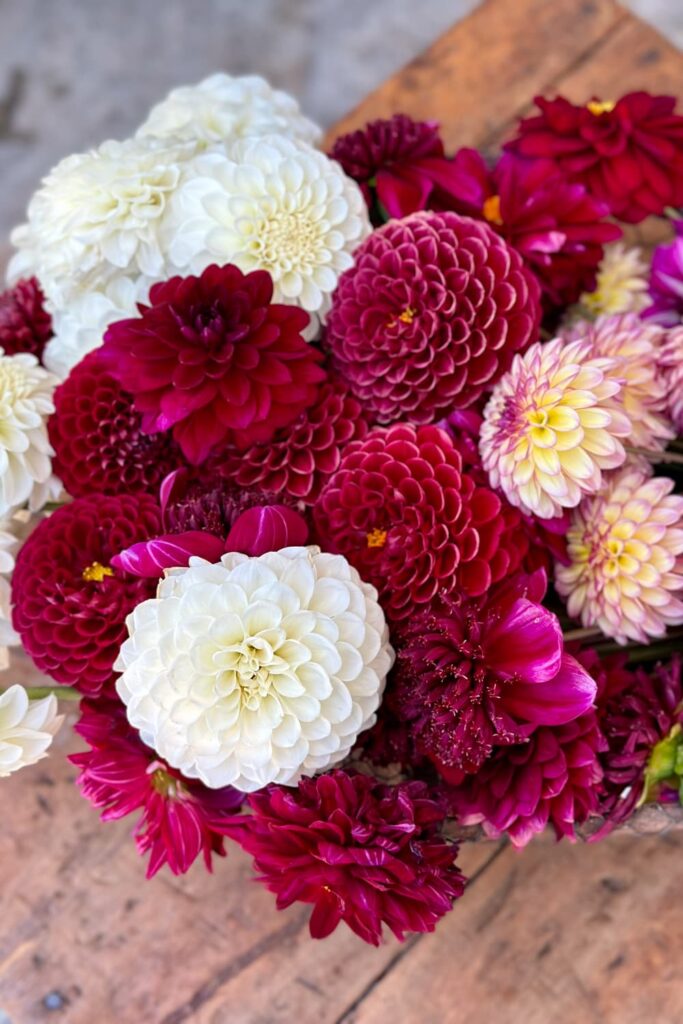
Let’s dive into the world of deadheading dahlias in pots as I share tips and insights to help you keep your blooms thriving. First, we’ll cover the basics of how to grow dahlias to get us on the right track. So, grab your gardening gloves, and let’s get started!
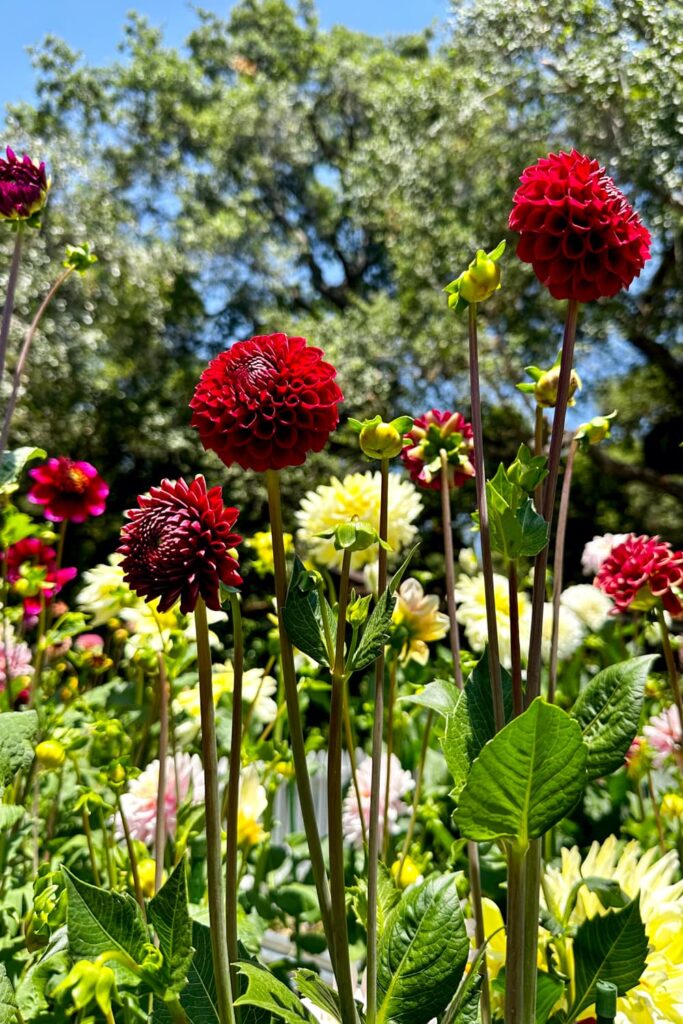
What are dahlias?
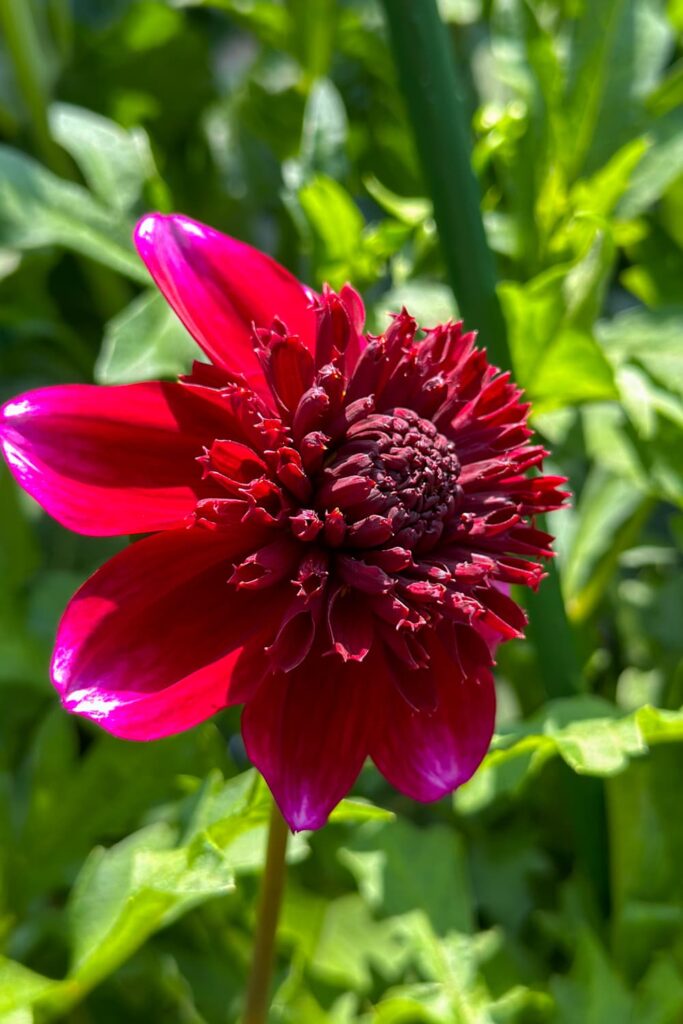
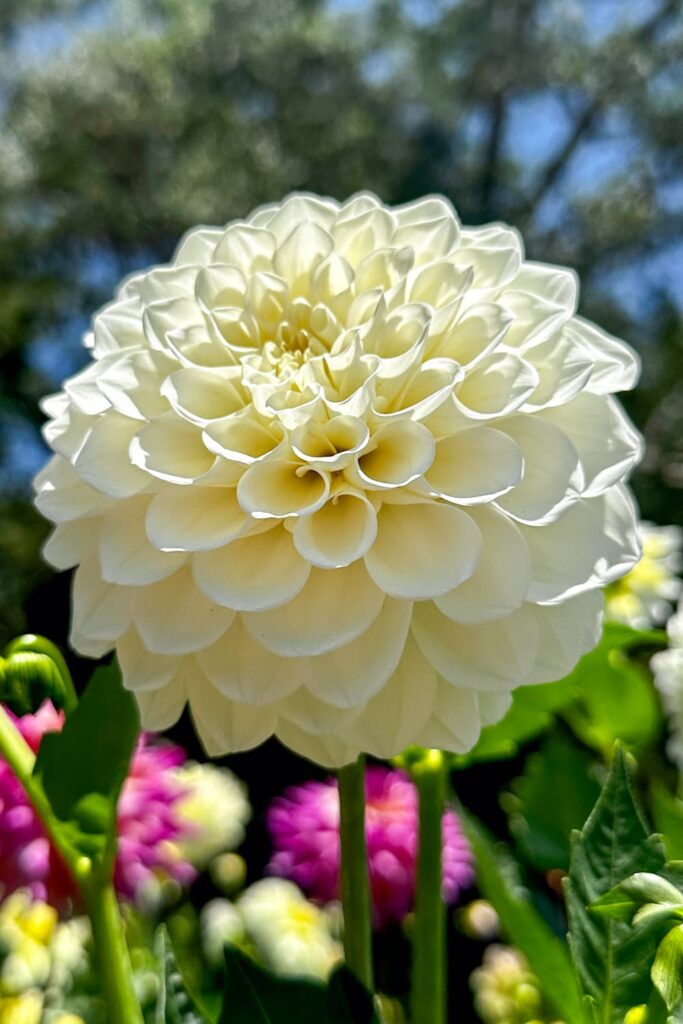
Let’s take a moment to appreciate the beauty and diversity of these remarkable plants. Dahlias belong to the Asteraceae family and are native to Central America and South America. They are prized for their stunning blooms, which come in a wide range of colors, shapes, and sizes, ranging from 2″ to 12″ in width.
Dahlias are herbaceous perennials, meaning they grow and flower for multiple years. Their tuberous roots store nutrients, allowing them to survive dormant periods and re-emerge in the following growing season. Dahlias can grow anywhere from one to six feet tall, depending on the variety, and their foliage ranges from delicate and lacy to broad and bold.
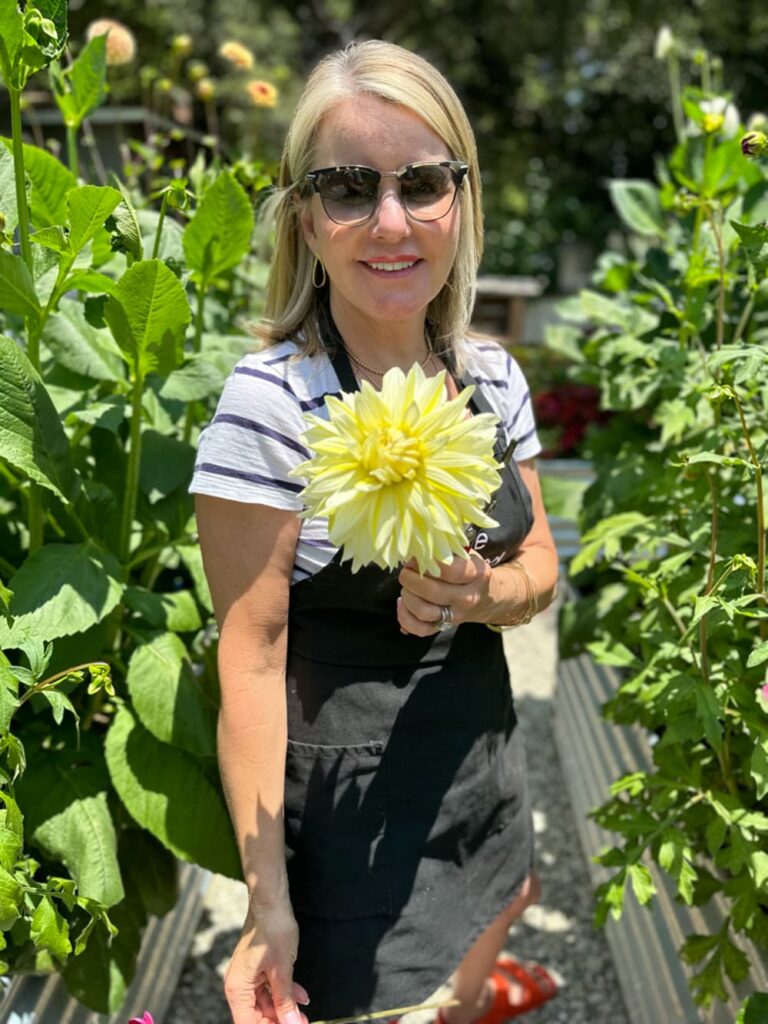
What sets dahlias apart is their incredible diversity. From pompom and cactus dahlias with intricate petal arrangements to dinnerplate dahlias that produce enormous blooms, there are dahlia varieties for every gardener’s taste. With thousands of varieties available, you can find dahlias in many colors, including vibrant reds, oranges, pinks, purples, and even unique bi-color combinations.
Whether you’re a novice gardener or an experienced enthusiast, growing dahlias in pots is a fantastic way to enjoy these beautiful flowers up close and personal. You can grow dahlias in pots as quickly as in the ground or raised beds. Use a large pot made of plastic or a clay pot to grow dahlias in a small space. They also make lovely cut flowers to bring indoors. Dahlias are very easy to grow if you follow a few simple steps.
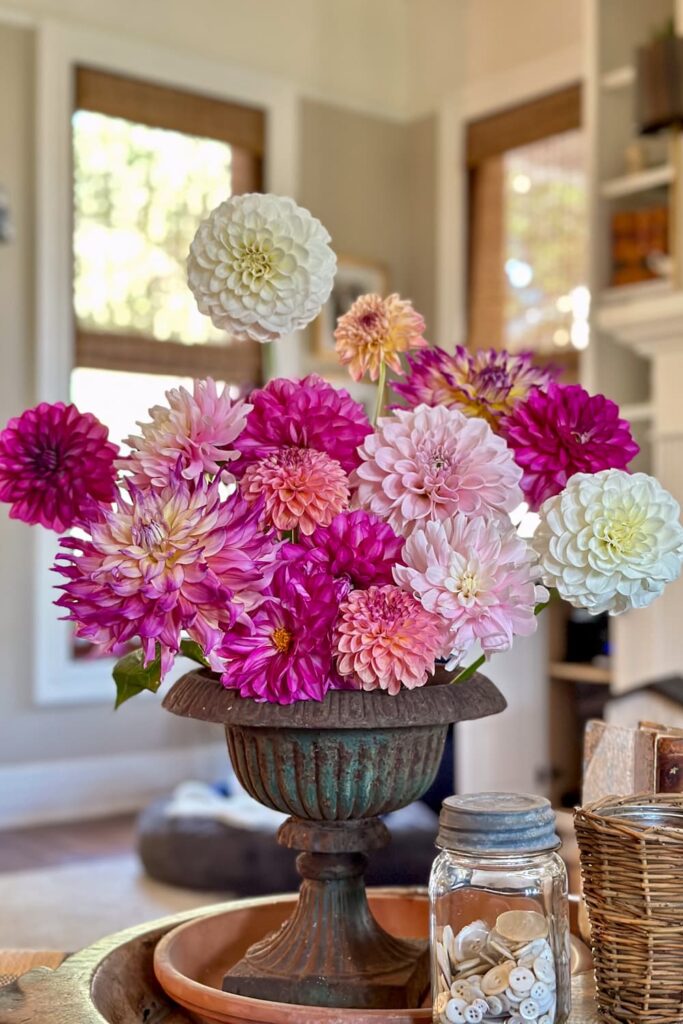
On my blog WM Design House, I may sometimes use affiliate links, which means a small commission is earned if you purchase via the link. The price will be the same whether you use the affiliate link or go directly to the vendor’s website using a non-affiliate link.
How to grow dahlias
These tender perennials (depending on your USDA hardiness zone) come in several varieties with excellent flower production, and they love the hot summers.
For the best results, follow these guidelines:
- Purchase your tubers or seed from a well know grower or garden center. I buy all of my dahlias @sccflowergardens.
- The best time to plant the tubers or seeds is well after the last frost date has passed.
- Place them in the full sun, with 6-8 hours of direct sun.
- Plant in soil with good drainage and lots of organic matter, such as peat moss.
- Keep them in moist soil and always water at the base of the stem.
- Pinch them back as they grow into bushier plants.
- Dahlia blooms can become heavy, so it is essential to use wooden stakes to support them as they grow.
- Fertilize the dahlias regularly with bone meal, and remember that they do not like too much nitrogen in their fertilizer.
- A good rule of thumb is to spray occasionally to avoid fungal diseases, powdery mildew, and unwanted pests for healthy plants.
What is the dahlia blooming season?
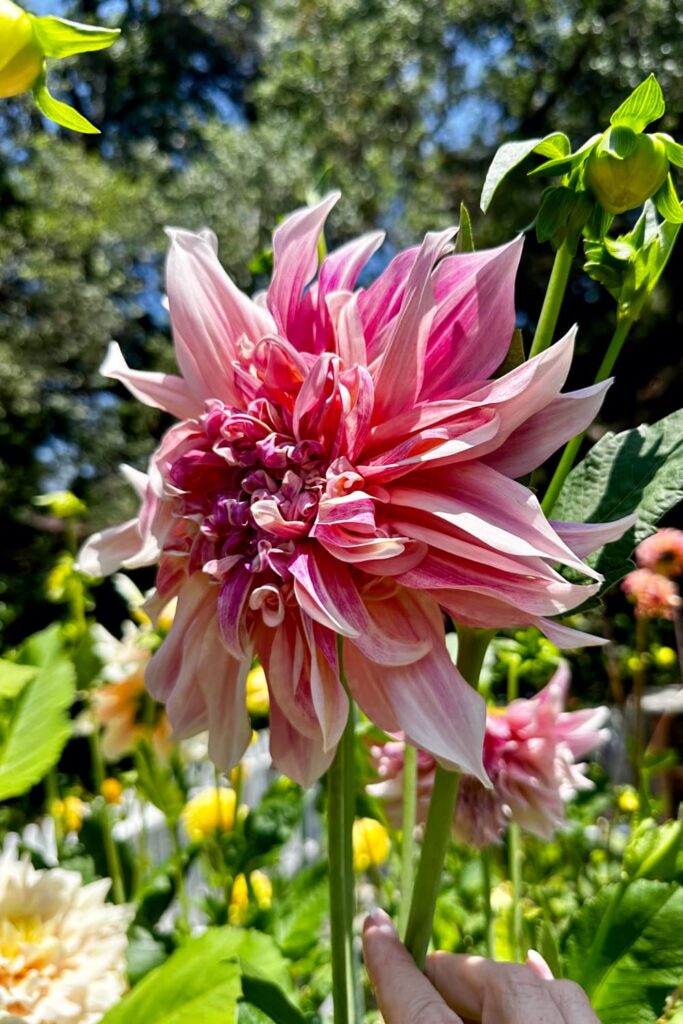
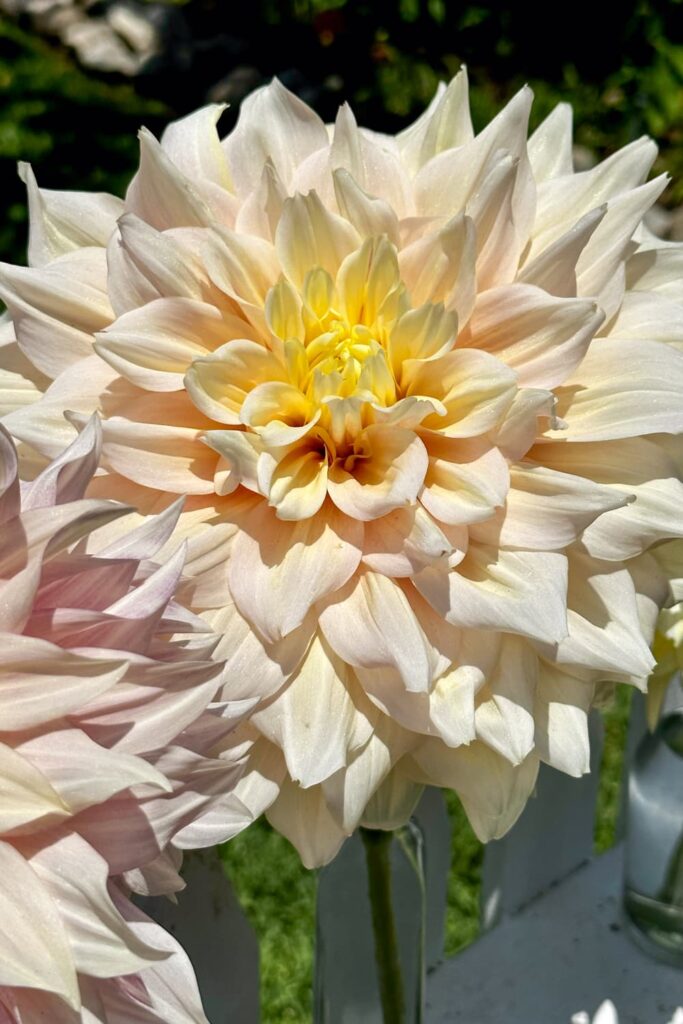
Dahlias are flowering plants that thrive in warm weather and typically start blooming from early summer until the onset of fall. Their blooming period usually ends a few months after the soil has warmed up, extending until early to mid-fall. It’s important to note that various factors, such as the specific environment and the dahlia variety, can influence their blooming season’s timing and duration.
Will dahlia plants bloom all summer?
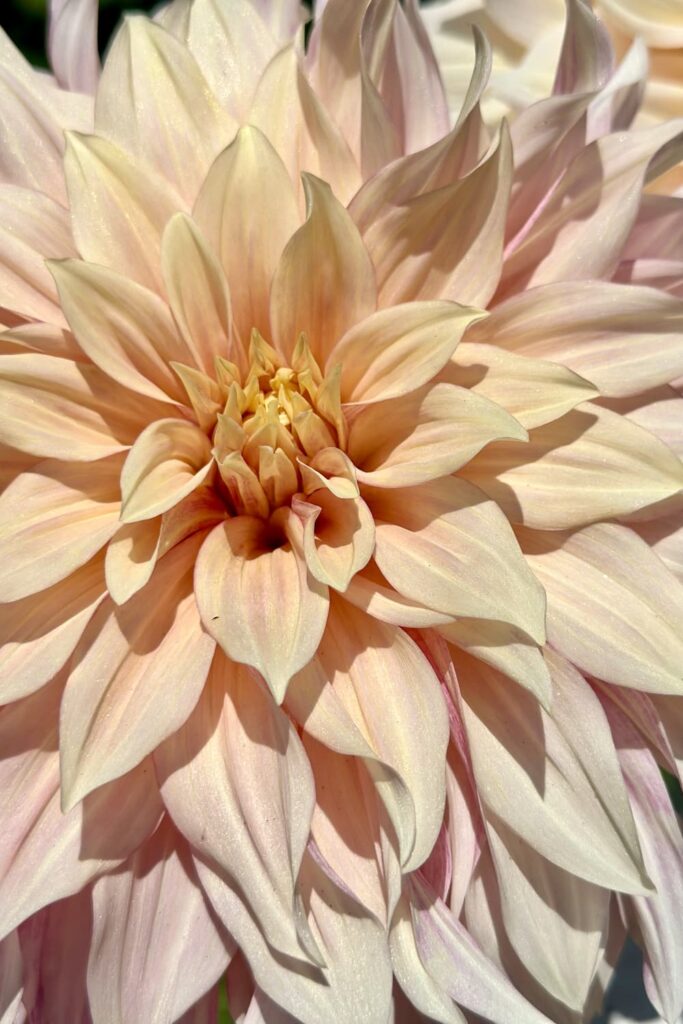
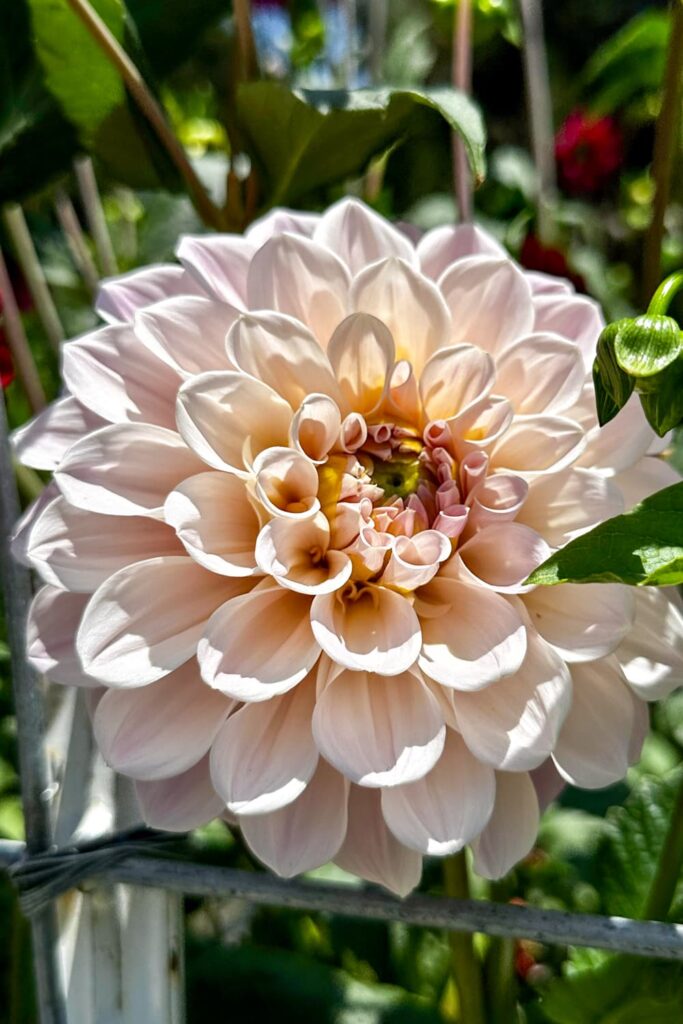
Dahlias will bloom all summer with proper care and consistent deadheading. I also feed my Dahlias every few weeks during the summer months for optimal growth and new blooms. Remember, they love bone meal and dislike fertilizers with too much nitrogen.
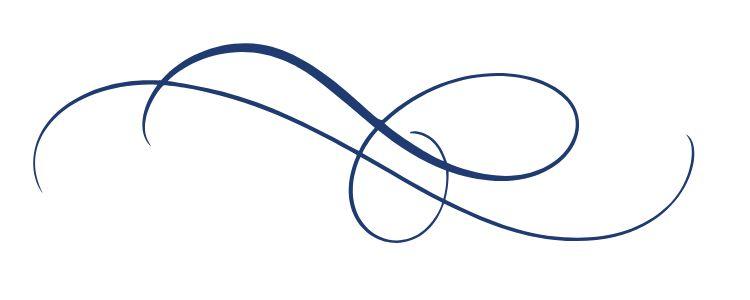
Understanding deadheading
Before we jump into the specifics of deadheading dahlias, let’s quickly understand what it entails. Deadheading is the process of removing spent flowers from a plant. By doing so, we redirect the plant’s energy from seed production to new growth and encourage the development of more blooms. Deadheading is a simple yet effective practice that promotes the longevity and continuous flowering of dahlias in pots.
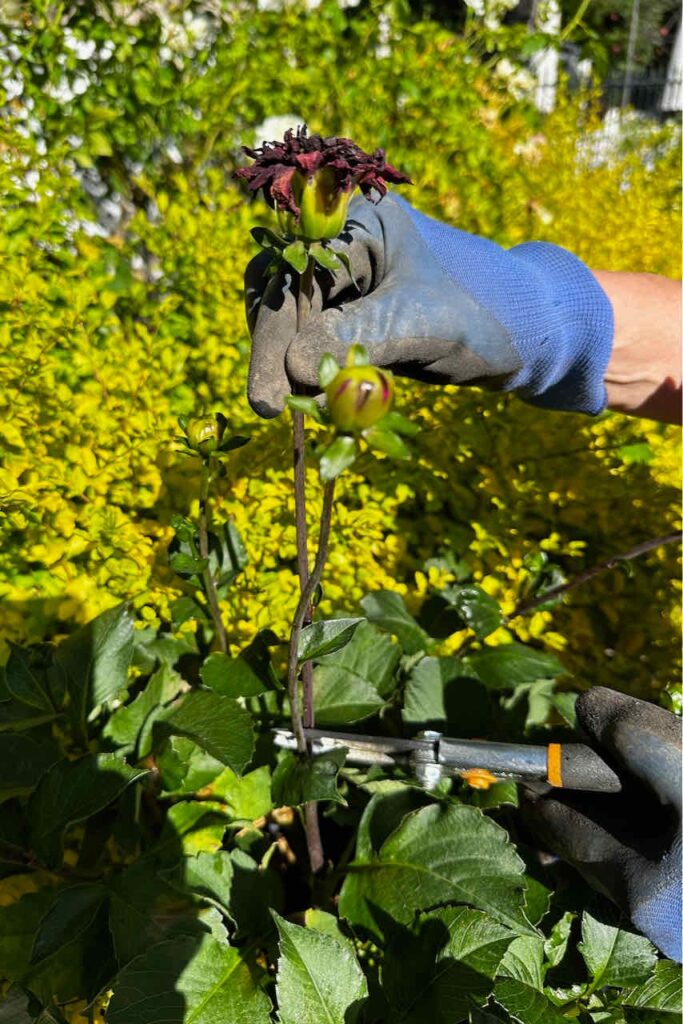
Should you deadhead dahlia flowers?
When it comes to dahlias, deadheading is highly beneficial for several reasons.
- Removing the faded blooms encourages the plant to produce more flowers, resulting in an extended blooming season.
- Deadheading also helps improve the overall appearance of the dahlia plant by tidying up the garden or container.
- Additionally, removing spent flowers redirect the plant’s energy towards new growth and development rather than seed production.
This can lead to healthier and stronger dahlias with more vibrant and abundant blooms.
When to deadhead dahlias
Timing is everything when it comes to deadheading dahlias. You want to remove the spent flowers at the right stage to maximize the plant’s blooming potential. Wait until a dahlia flower has completed its entire cycle, from the initial bloom to the point where it starts to fade and wither. This is the ideal time to deadhead. Removing the spent flower at this stage prevents seed formation and redirects the plant’s energy toward producing more beautiful blossoms.
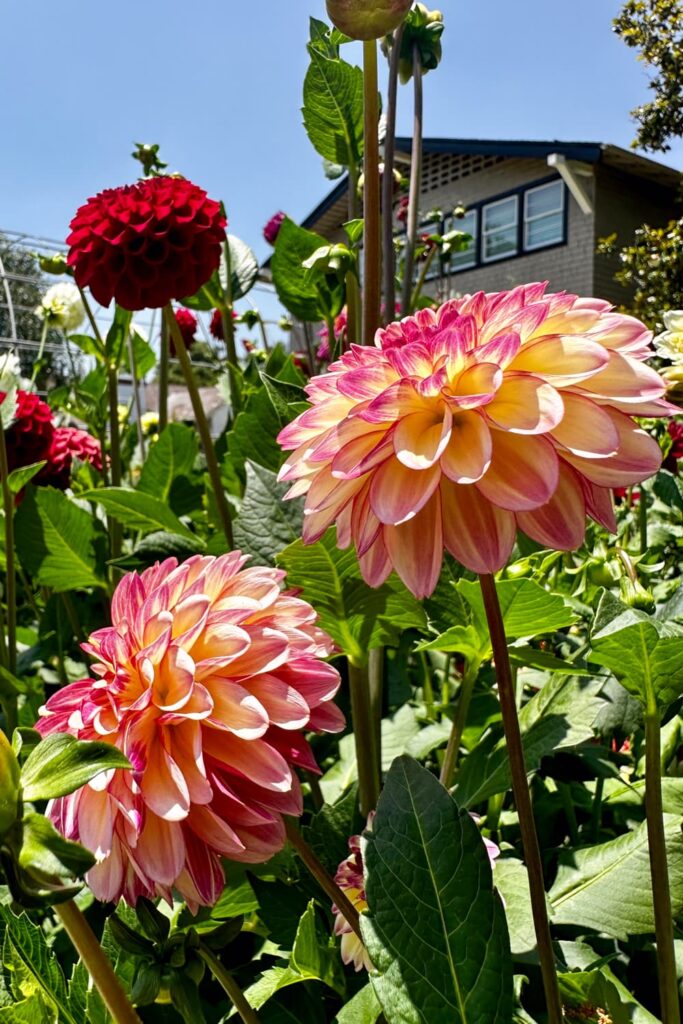
How often do dahlias need to be deadheaded?
Dahlias generally require regular deadheading throughout their blooming season. Depending on how quickly the flowers fade, I recommend deadheading dahlias every few days or at least once a week.
I tend to do this daily since I am in the garden every day.
Removing faded blooms promptly encourages the plant to produce new flowers and maintain a neat and tidy appearance. Regular deadheading also prevents the plant from diverting energy into seed production, allowing it to focus on continuous flower production.
However, it’s worth noting that individual dahlia plants may have variations in their blooming patterns, so it’s important to observe and adjust the deadheading frequency accordingly.
What are spent flowers?
Spent flowers refer to flowers that have reached the end of their life cycle and have started to wither or fade.
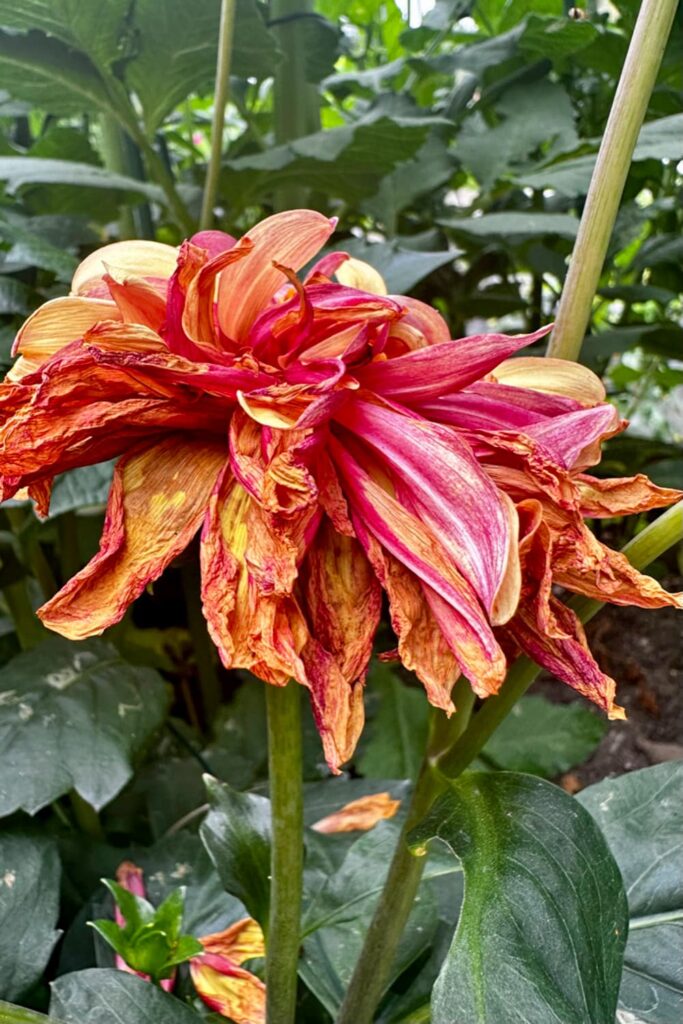
I prefer to cut my flowers long before they are spent to enjoy them in the house. However, a few always get left behind and need to be deadheaded.
These spent flowers have completed their primary purpose of pollination and seed production.
Spent flowers are no longer vibrant or attractive and may show signs of wilting, browning, or petal discoloration.
They are essentially past their prime and are no longer contributing to the overall health or aesthetics of the plant.
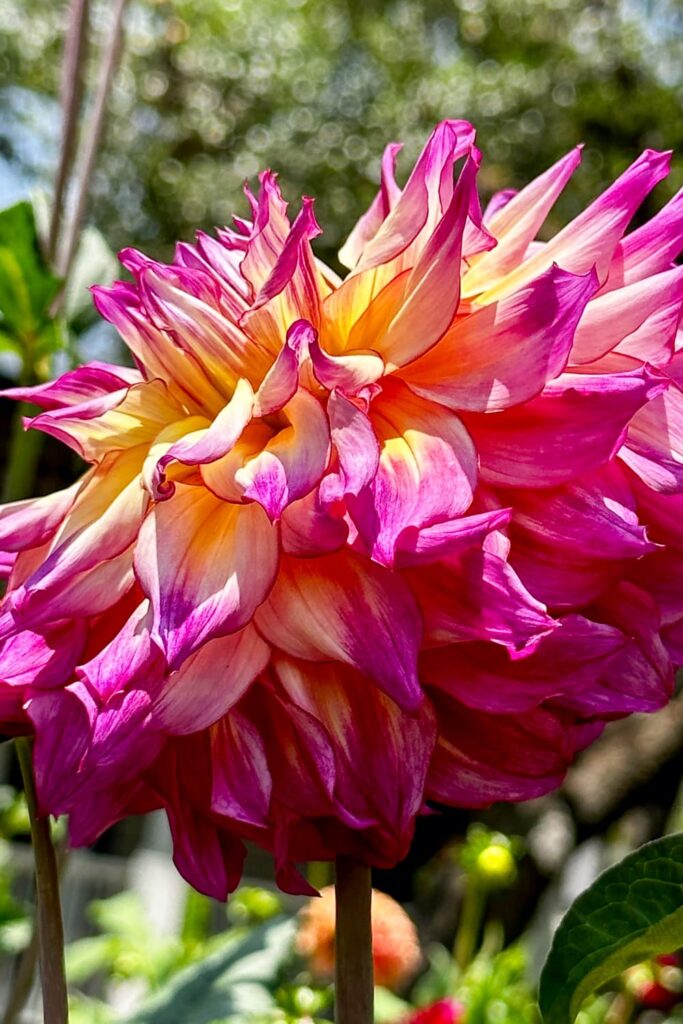
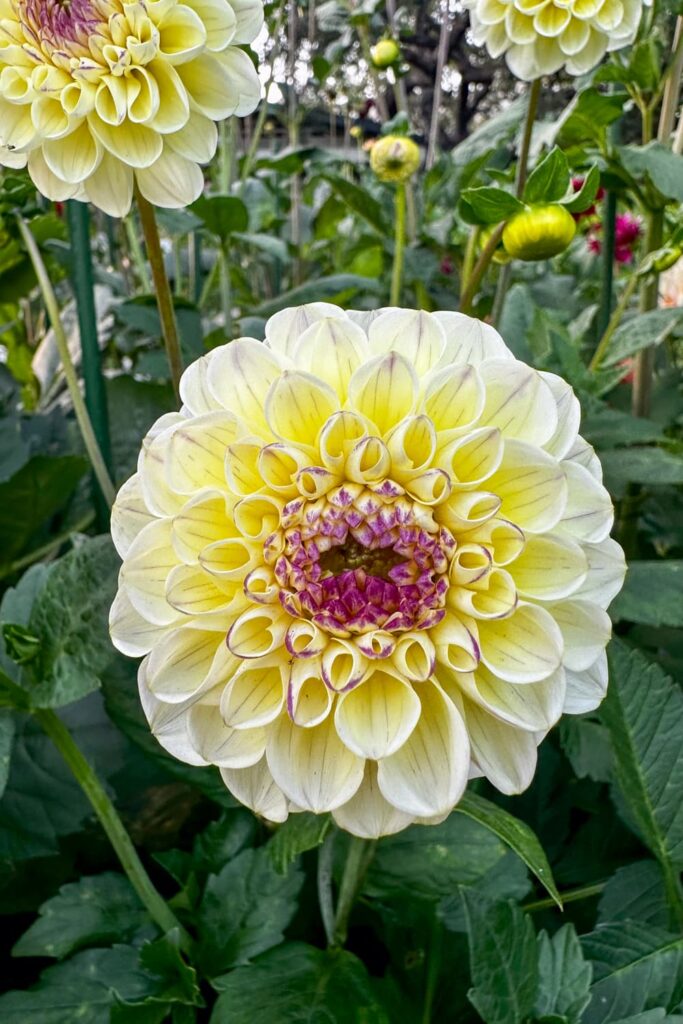
What is the difference between a spent bud and a new bud?
Distinguishing between a spent bud and a new bud on a dahlia plant can be done by examining their appearance and stage of development. Here are a few characteristics to look for:
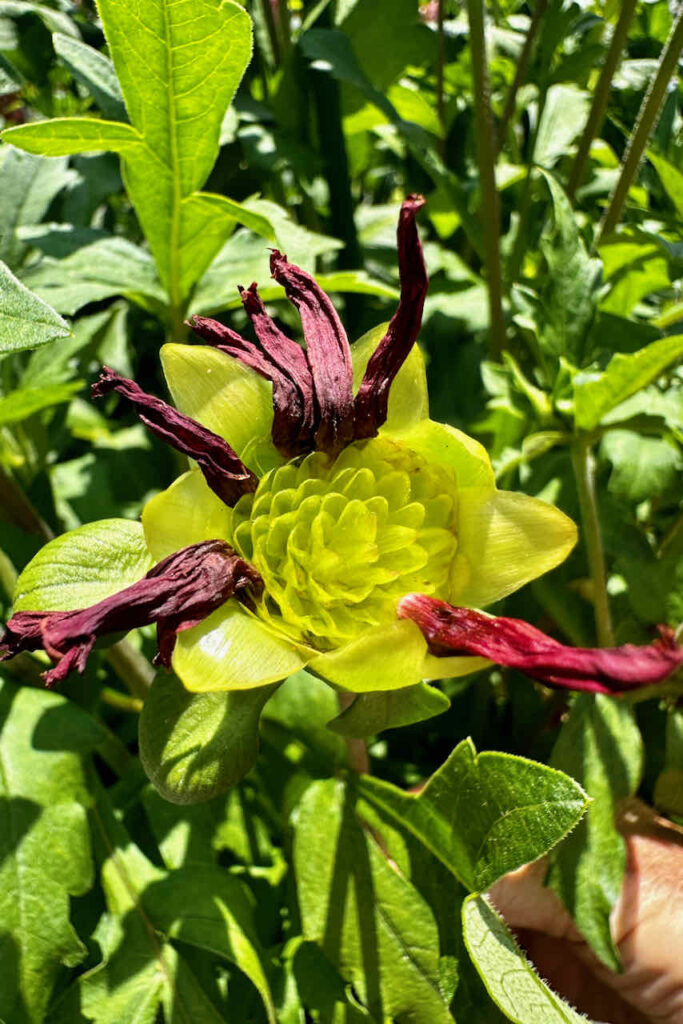
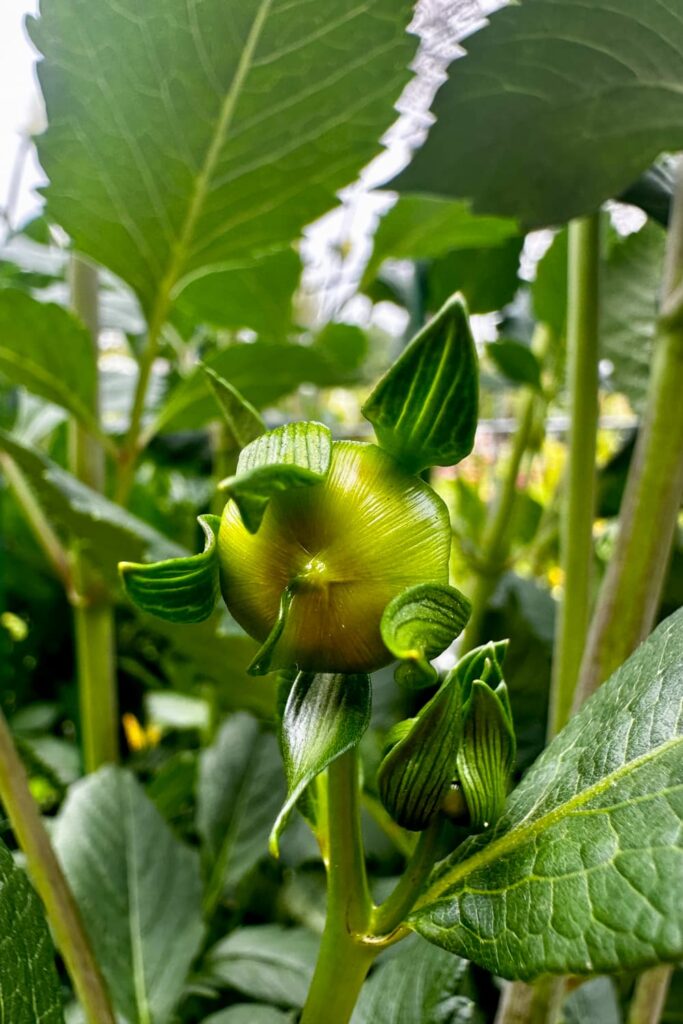
- Spent Bud: A spent bud is typically faded, wilted, or discolored. Its petals may have started to dry out or fall off. The overall appearance of a spent bud is dull and lifeless.
- New Bud: A new bud, on the other hand, will appear fresh, vibrant, and tightly closed. It often has a healthy color and shows no signs of wilting or discoloration. The new bud is still in the process of maturing and is ready to open up into a flower.
By closely observing the buds on your dahlia plant, you can identify the spent flower heads based on their deteriorated appearance and differentiate them from the new buds that display vitality and readiness for blooming.
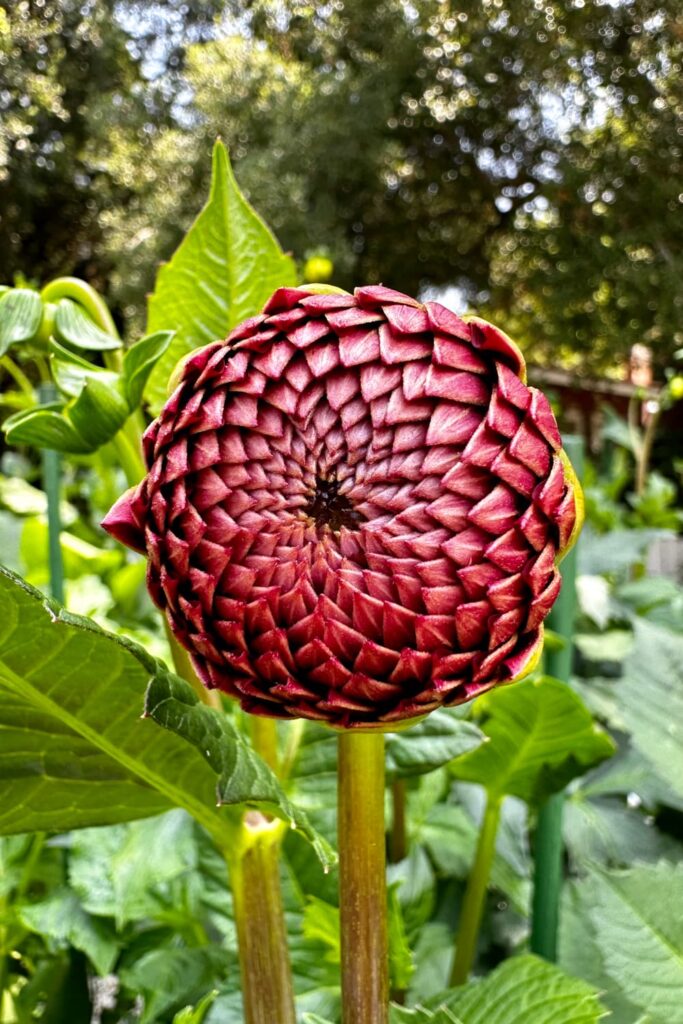
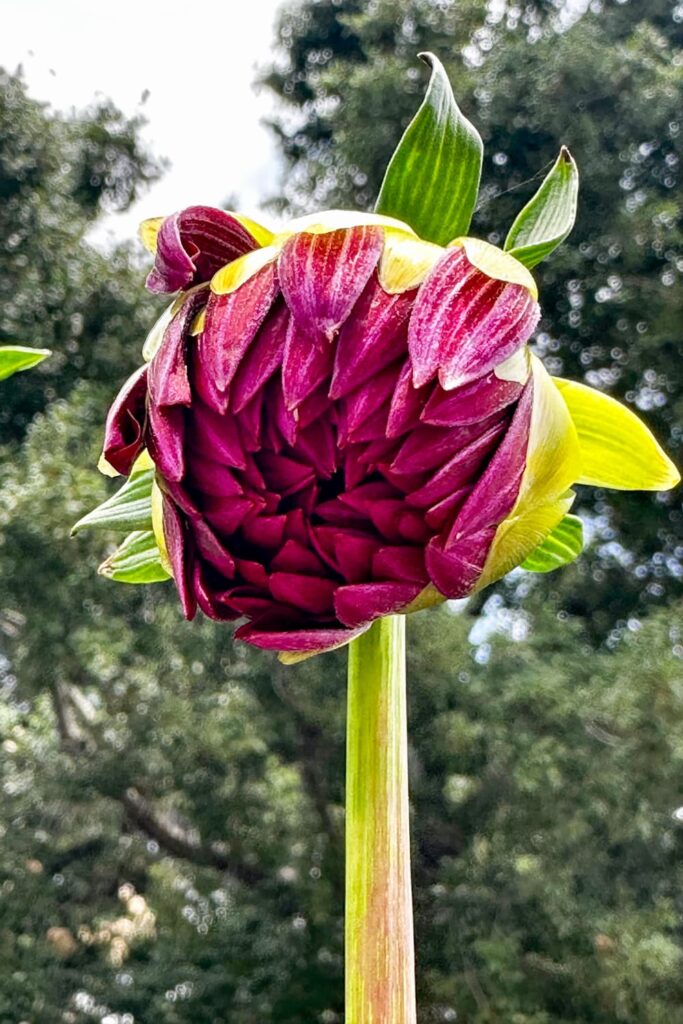

What you’ll need for deadheading dahlias in pots
Before you start, gather the necessary tools. For deadheading dahlias in pots, you’ll need a few essential items:
- a pair of clean, sharp pruning shears or scissors
- a container to collect the discarded flowers
- gloves to protect your hands from thorns and prickles.
Having these tools handy will make the process smoother and more enjoyable.
How to remove dead flowers (where to cut)
Deadheading dahlias in pots is a relatively simple process. To remove dead flowers from a dahlia plant, you can follow these steps:
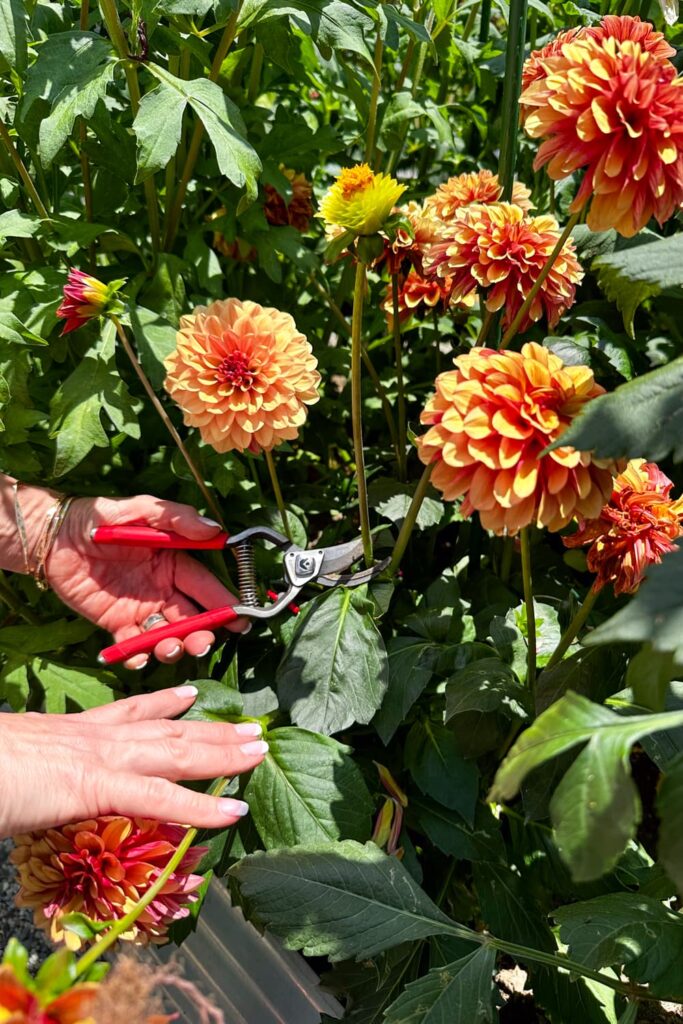
1. Identify the spent blossoms
Examine the dahlia plant and locate the faded or withered flowers ready for removal. These flowers have completed their bloom cycle and are no longer vibrant.
2. Get the right tool
Use clean and sharp garden scissors, pruning shears, or a sharp pair of secateurs to remove the dead flowers. Make sure the tool is sanitized to minimize the risk of spreading diseases.
3. Locate the stem
Follow the stem of the spent flower to the point where it meets a main branch or another stem.
4. Cut at the right spot
Position the blades of your tool just above the main branch or stem and make a clean cut. Aim to remove the entire faded flower, including the stem portion.
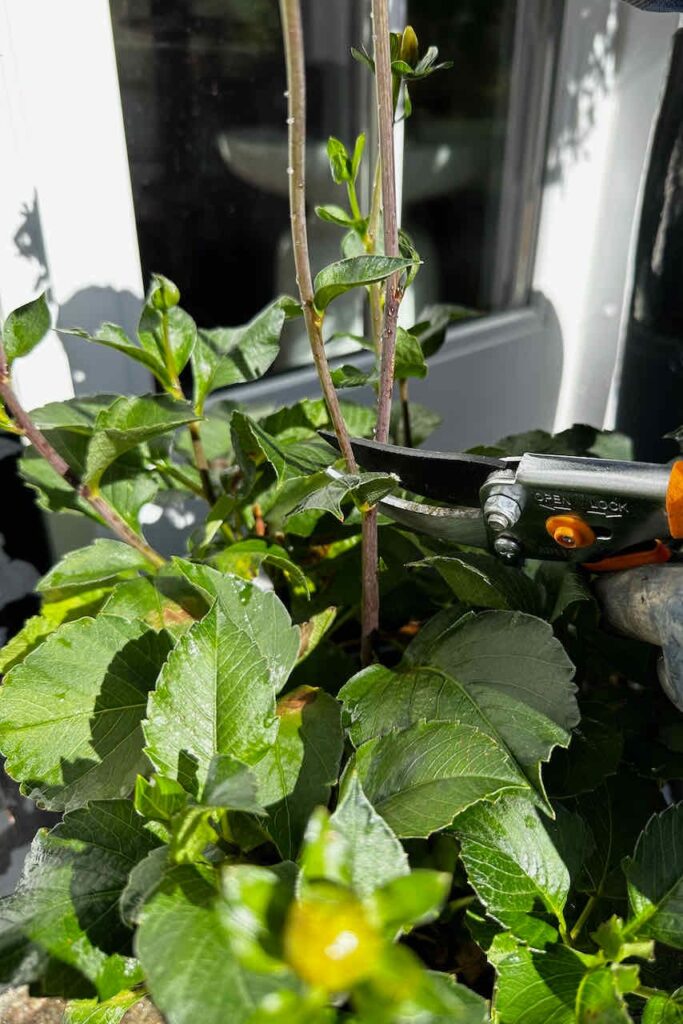
5. Repeat the process
Move on to the next spent flower and repeat the same process. Continue deadheading the dahlia plant by removing all the faded flowers.
Using the right tools, you can easily remove the dead flowers from the dahlia plant without damaging the rest. Consider deadheading regularly to encourage new blooms and maintain the plant’s appearance.
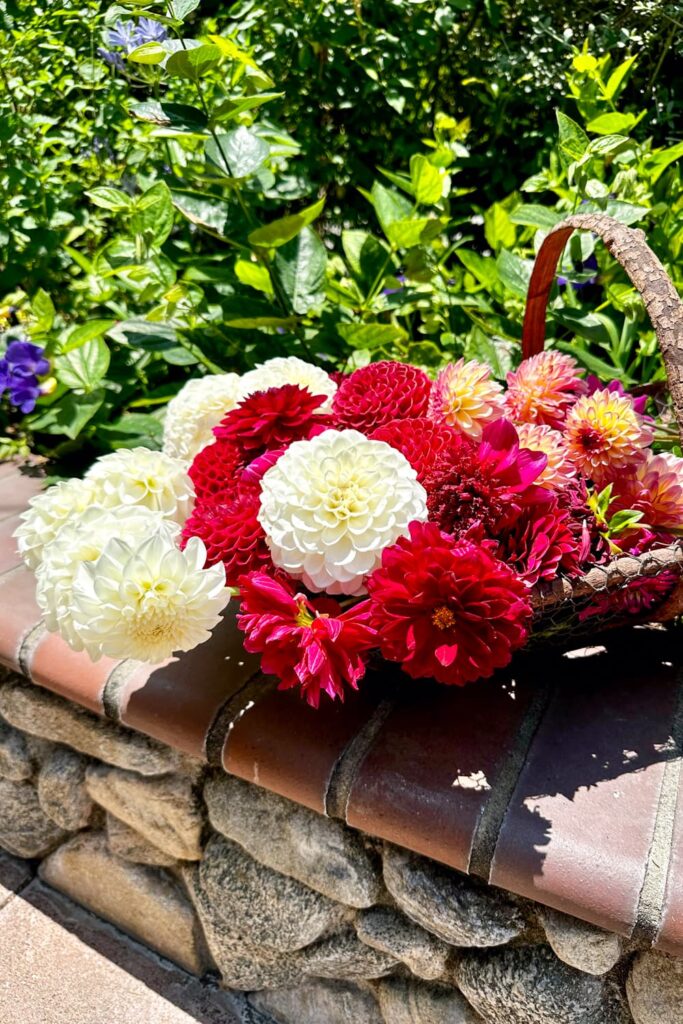
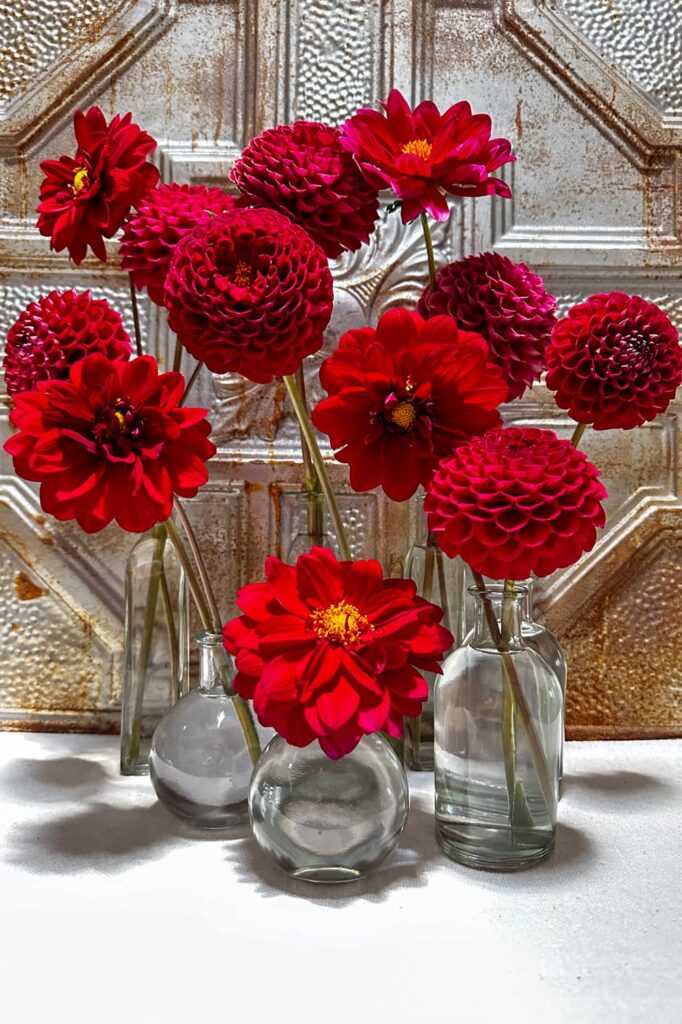
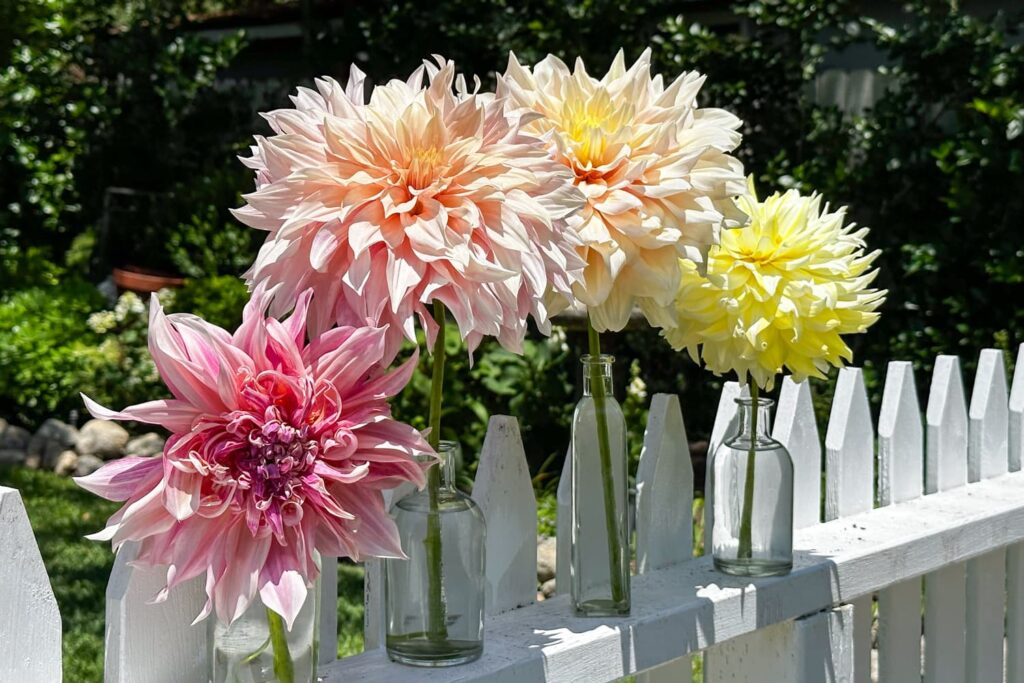

When do you cut back dahlias?
To properly cut back dahlias, follow these guidelines:
- Timing: Wait until after the first frost or when the foliage has turned brown and died back naturally. This usually occurs in late fall or early winter. Cutting back too early may prevent the tubers from fully maturing.
- Prepare tools: Gather a pair of clean and sharp pruning shears or loppers to ensure clean cuts.
- Assess the plant: Examine the dahlia plant and identify the main stems.
- Cut back the stems: Cut the main stems to about 4-6 inches above ground level. Make a clean diagonal cut just above a node or bud. This promotes new growth in the following season.
- Remove foliage: Trim off all the remaining foliage from the stems. Remove the leaves close to the main stems, leaving only a short stub.
- Clean up: Collect and discard the cut stems and foliage. Properly dispose of any diseased or infested plant material to prevent the spread of pests or diseases.
- Optional: If desired, you can dig up the dahlia tubers for winter storage. Gently lift the tubers from the soil, remove excess dirt, and store them in a cool, dry place for the winter months.
By following these steps, you can effectively cut back your dahlias, promoting healthier growth in the next growing season.

Additional tips for deadheading dahlias in pots
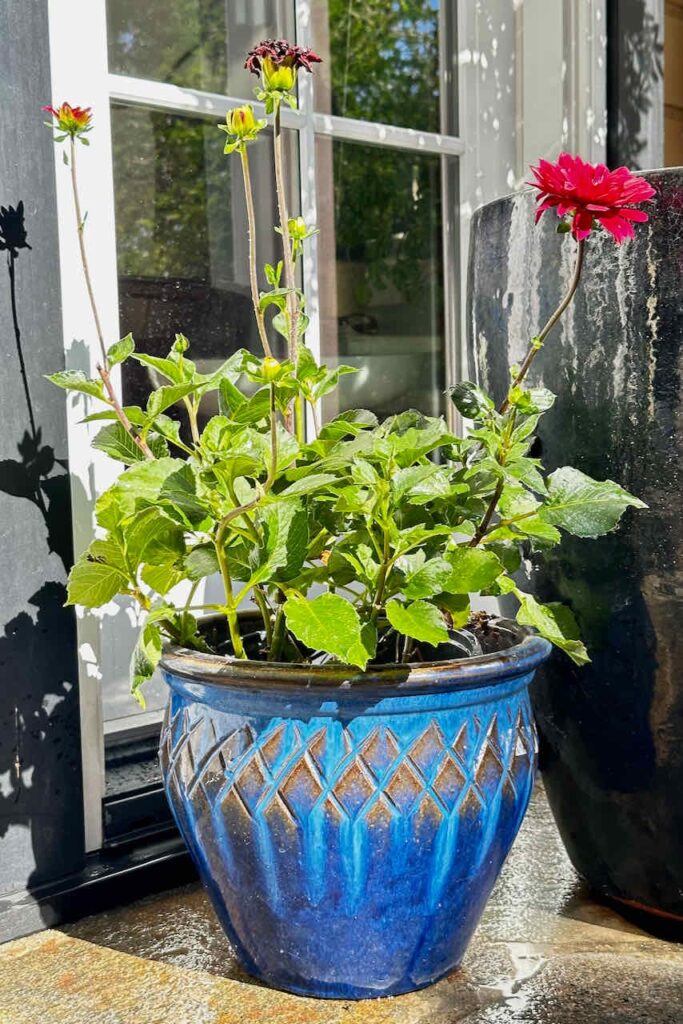
- Use a sharp pair of scissors or shears to make a clean cut. This will help to prevent the plant from becoming infected.
- Cut the spent blooms at the base of the stem, just above a healthy leaf. This will encourage new blooms to grow from the same stem.
- Aim for a diagonal cut, which allows water to run off quickly, minimizing the risk of rot or disease.
- Deadhead dahlias in the morning or evening when the plant is cool and dry. This will help to prevent the spread of disease.
- If you are deadheading many dahlias, you may want to consider using a flower trimmer. This will make the process go more quickly and easily.
Additional care suggestions
While deadheading plays a vital role in maintaining the health and beauty of your potted dahlias, you should keep a few more care tips in mind.
- Provide your plants with adequate water, ensuring the soil is moist but not waterlogged.
- Fertilize regularly with a balanced, water-soluble fertilizer to supply essential nutrients.
- Protect your dahlias from extreme weather conditions like strong winds and excessive heat.
- Lastly, consider staking your plants to support their tall and robust stems.

Take away Tips for Deadheading Dahlias in Pots
- Deadheading is the process of removing spent blooms from a plant. This helps to encourage new blooms to grow and prevents the plant from wasting energy on producing seeds.
- To deadhead dahlias, use a sharp pair of scissors or shears to cut off the spent blooms at the base of the stem. Wear gloves if you have sensitive skin, as the sap from dahlias can irritate.
- You can deadhead dahlias as often as you like, but it is generally recommended every few days during the blooming season. This will help to keep your dahlias looking their best and encourage them to produce more blooms.
- If you are deadheading dahlias in the fall, be sure to do so before the first frost. This will help protect the plant from damage and ensure it survives the winter.
- Here are some additional tips for deadheading dahlias:
- Use a sharp pair of scissors or shears to make a clean cut. This will help to prevent the plant from becoming infected.
- Cut the spent blooms at the base of the stem, just above a healthy leaf. This will encourage new blooms to grow from the same stem.
- Deadhead dahlias in the morning or evening when the plant is cool and dry. This will help to prevent the spread of disease.
- If you are deadheading many dahlias, you may want to consider using a flower trimmer. This will make the process go more quickly and easily.
Deadheading dahlias in pots is a rewarding task that will keep your plants blooming abundantly throughout the season. Removing spent flowers redirect the plant’s energy, promoting continuous growth and vibrant blooms. Remember to deadhead at the right time, use the appropriate tools, and follow proper care practices to ensure your potted dahlias thrive.
I hope you found this post informative and have a bountiful season of growing dahlias.


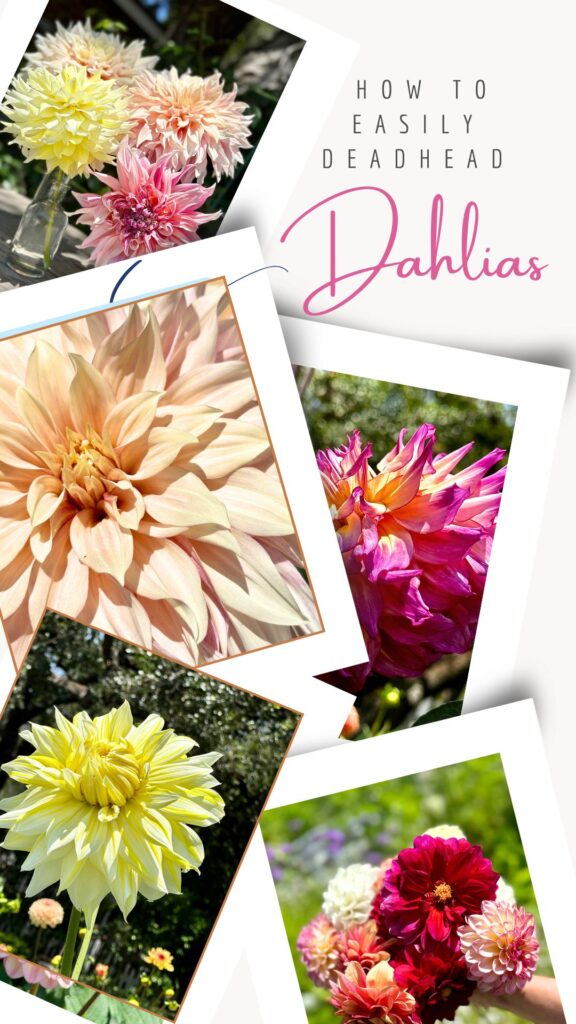
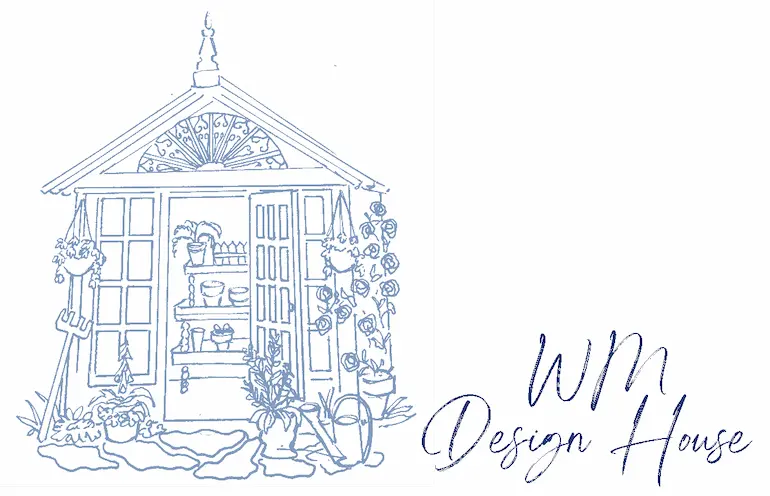
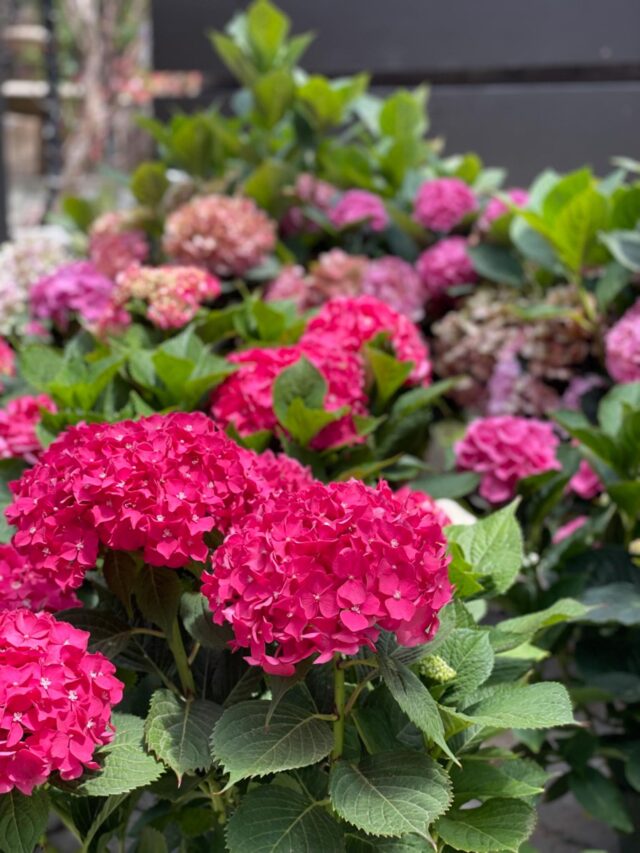
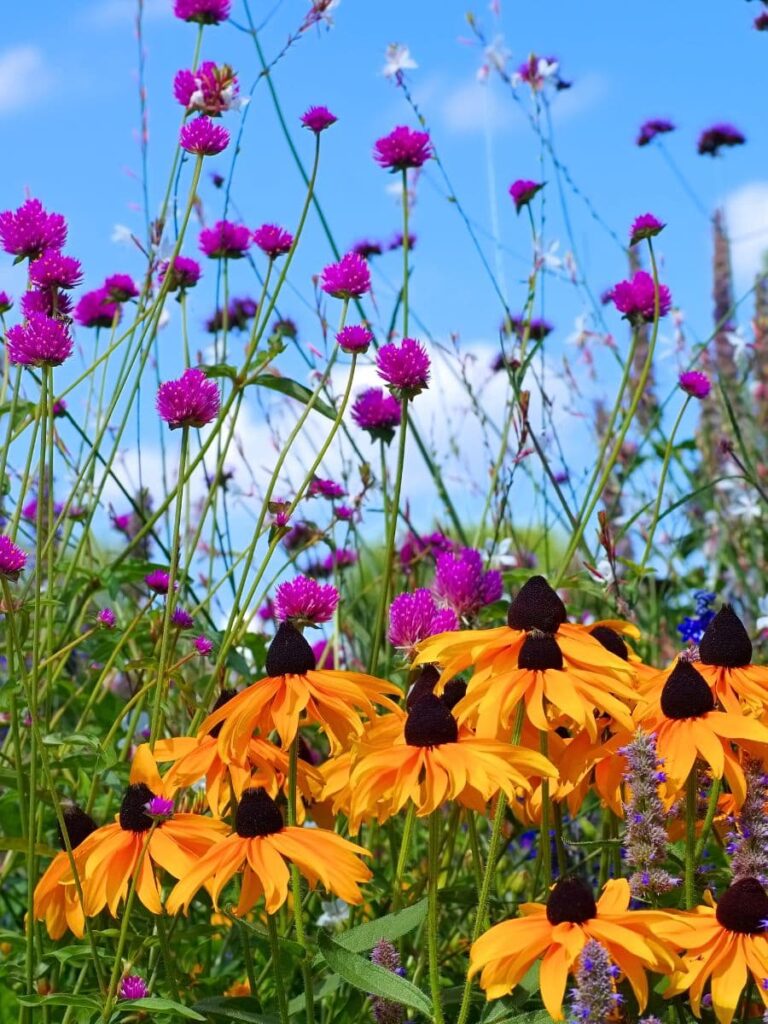
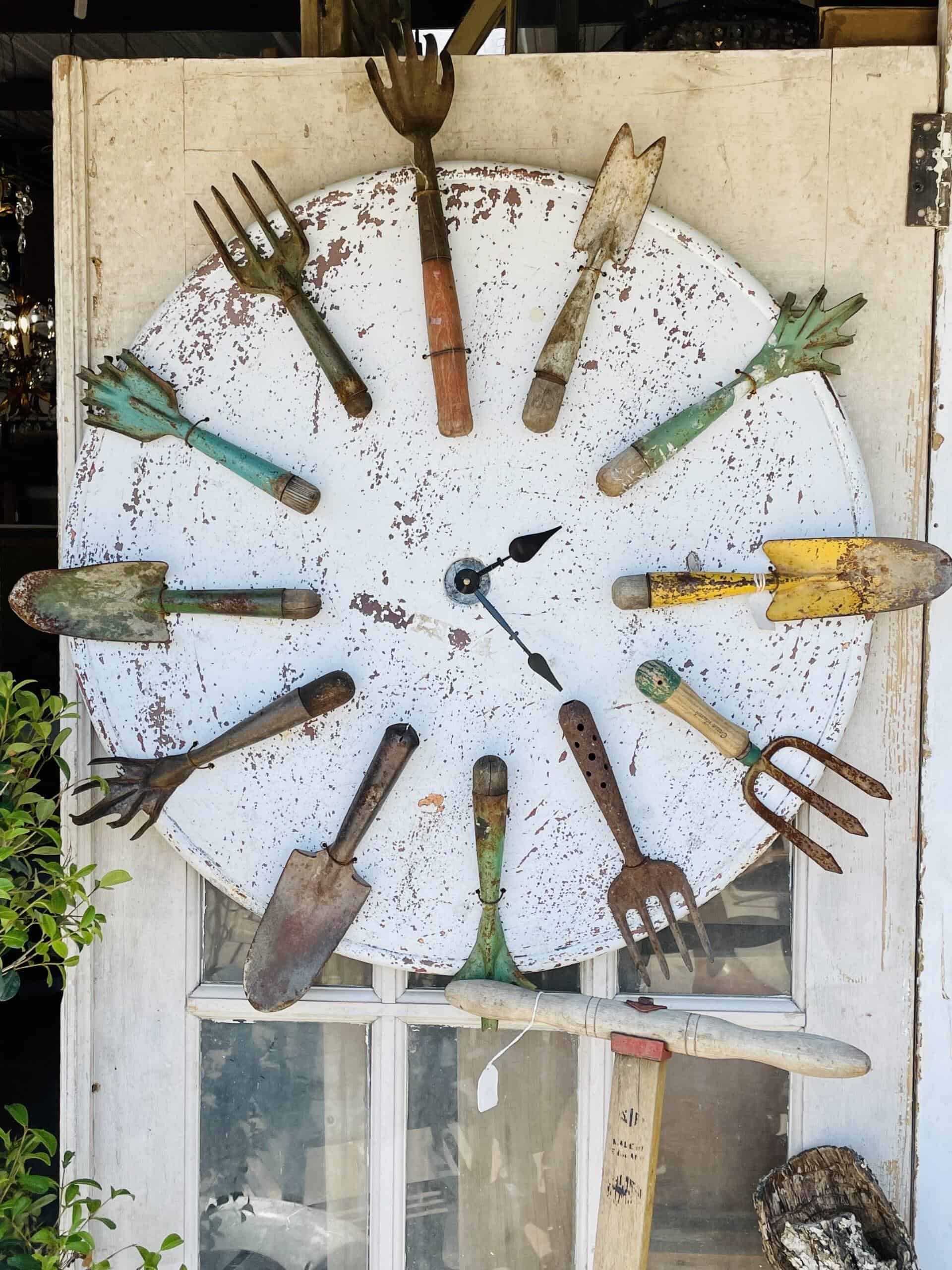
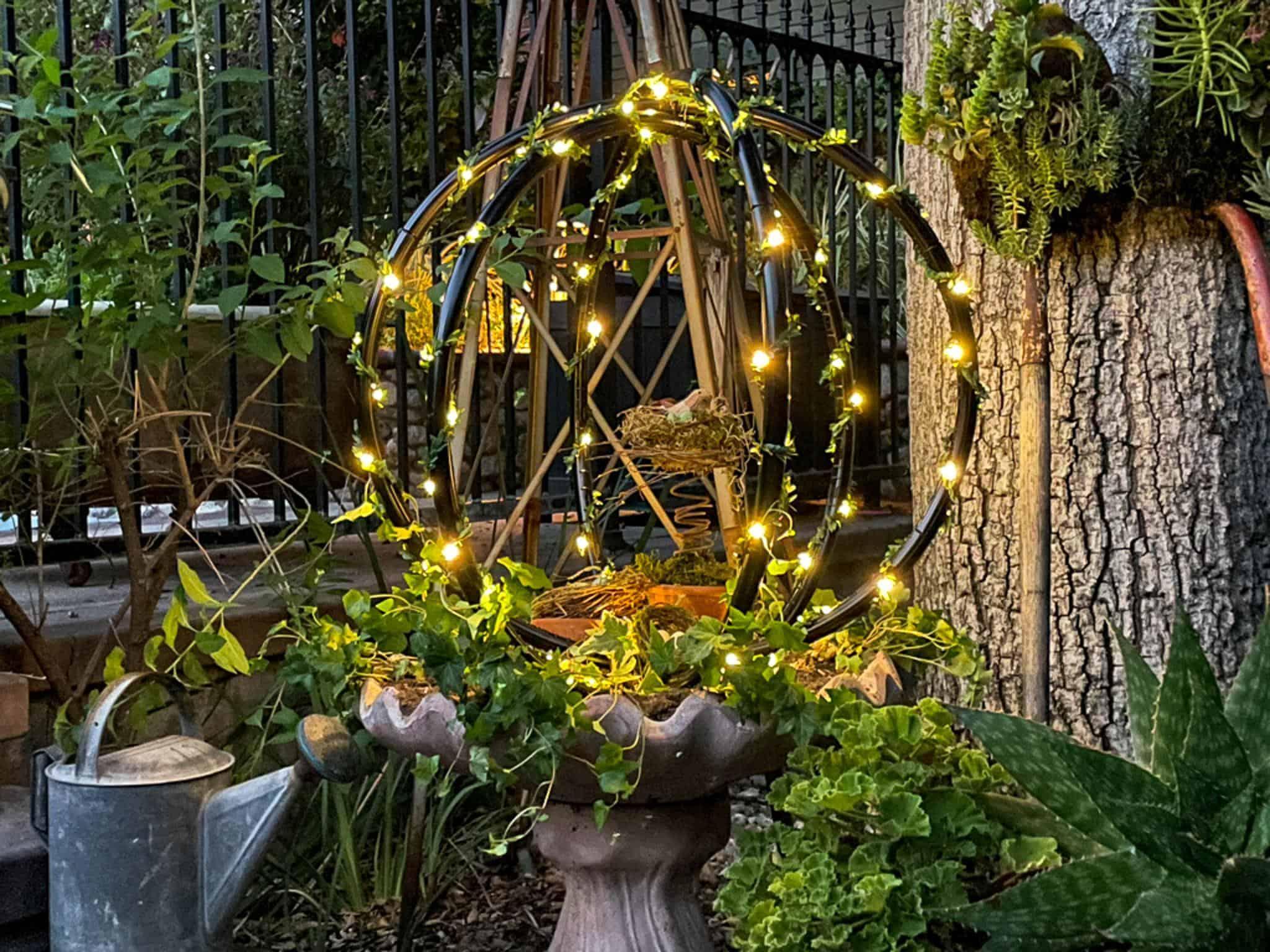
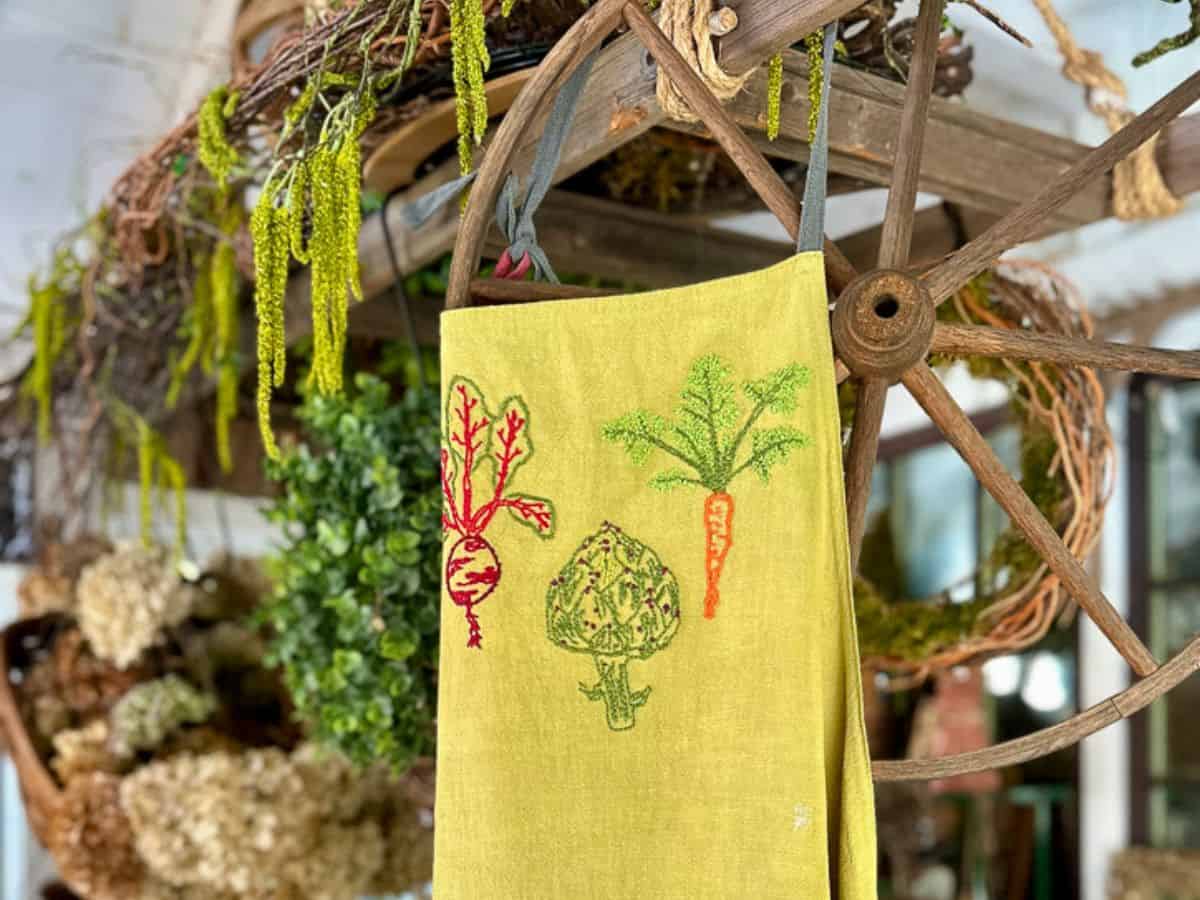
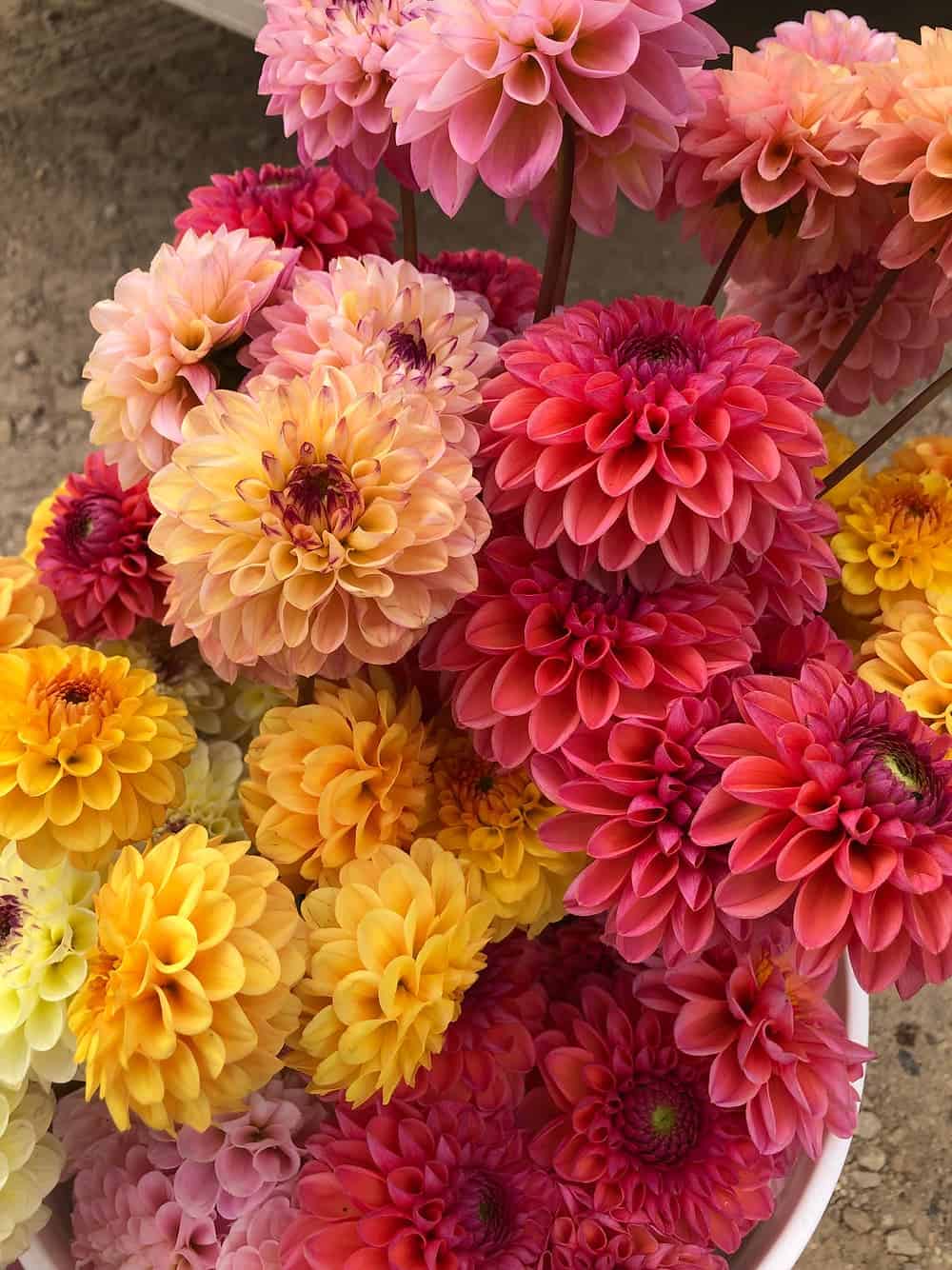
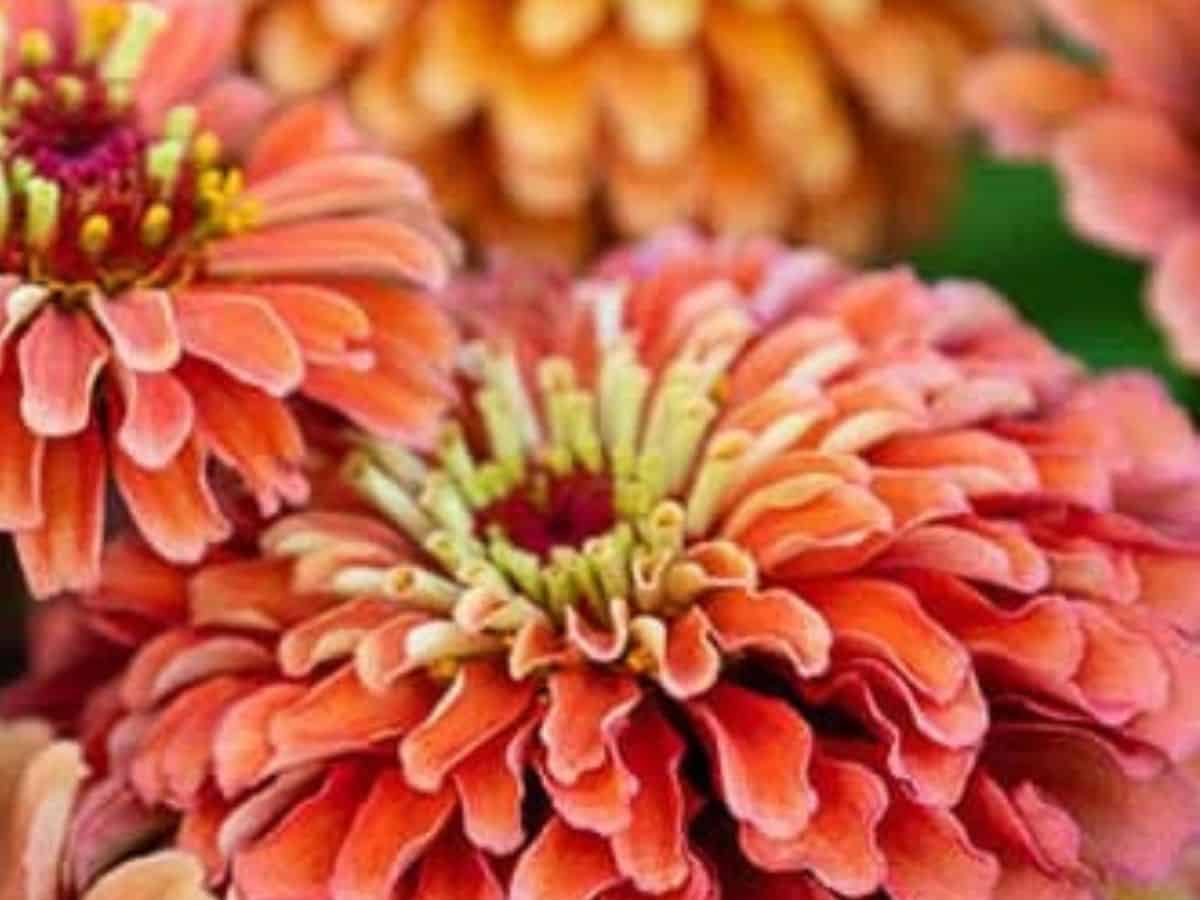
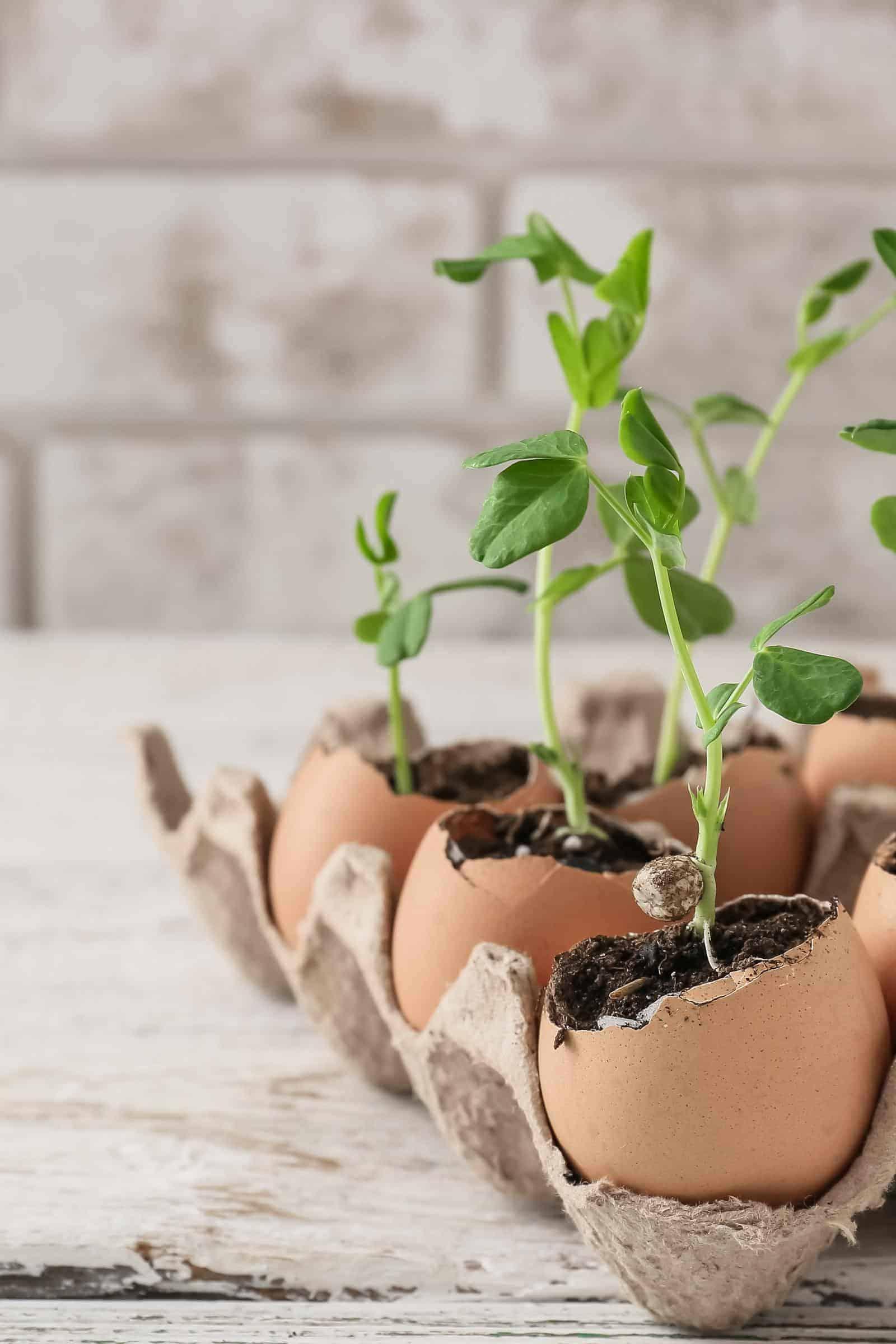
The variety and color of your dahlias are spectacular! There is so much great information in this post! Great job, Wendy!
This post is fantastic. I’m trying to grow dahlia’s for the first time this year. I’m really impressed with the size and beautiful ones you have grown. I’m going to have to keep at it over here. Thank you for all your tips!
Thank you, Susan, be sure to feed them bonemeal. They love it.
Hi Wendy – Dahlias are my favorite flowers. I have a number of tubers in my garden too and am eagerly waiting for them to bloom! Thanks for all the tips and the beautiful photos. Given that we have freezing temperatures here in NY during the winter – I have to dig up my tubers at the end of every season. Then I have to find a place to store them thats 45-50 degrees. It requires some extra work but if the tubers survive – its worth it! Thanks for the inspiration. Pinned!
I am thrilled to know you are a Dahlia lover, Anna. They are just the prettiest flowers. I have had several dinner plate dahlias that are larger the 10-12″ across this year.
I can’t wait to see yours. I am going to make sure I am signed up for your e-mail.
You have an awesome Dahlia garden, they are so beautiful.
Thank you from your SSPS Team for sharing your links with us at #269 SSPS Linky. If you have not shared your IG and FB URL and handles, please email me at [email protected] as I am creating a database as you share your links with SSPS.
This way I can more easily tag you when you’re in the top 5 and I promote your post. Thanks in advance
I love Dahlias Wendy, thank you for sharing! I may have to get over my fear of failure in the flower beds and give it another shot. You definitely make me think I can do it, like Rosie the Riveter! I actually have an add from 1924 about dahlias that I adore and hung in our home. They had such class then.
Cara, If you try using a raised bed, it will help. Then you have control of the soil. Be sure to put it in the full sun and lots of water. I am happy to give you soil suggestions if you decide to get one.
The dahlias are just stunning this year. My granddaughters and I will have a little flower stand this weekend. I can’t wait.
Oh my goodness, I am sure your granddaughters will love having the stand! That sounds like so much fun. Since we removed the bushes, we have been talking about purchasing a feeding trough and using it for flowers and veggies so I could have a raised garden. I didn’t do so well with the regrowing lettuce, it browned and began to rot. I followed the directions, I will keep trying and see what happens. My mother who can grow anything says she just does not get it with me… I have no idea what my deal is and growing things. 🙁
Wendy, I love, love, love dahlias but they do not grow in Phoenix, AZ. I am planning a garden at our mountain cabin and I believe they grow there. Will bookmark this post for all your great tips and tricks. Thanks for sharing such lovely pictures~made my morning.
Awh, thank you so much, Mary. I am enjoying the Dahlia garden this year. I have so many. I don’t know what to do with them all. The girls are going to have a flower stand this weekend.